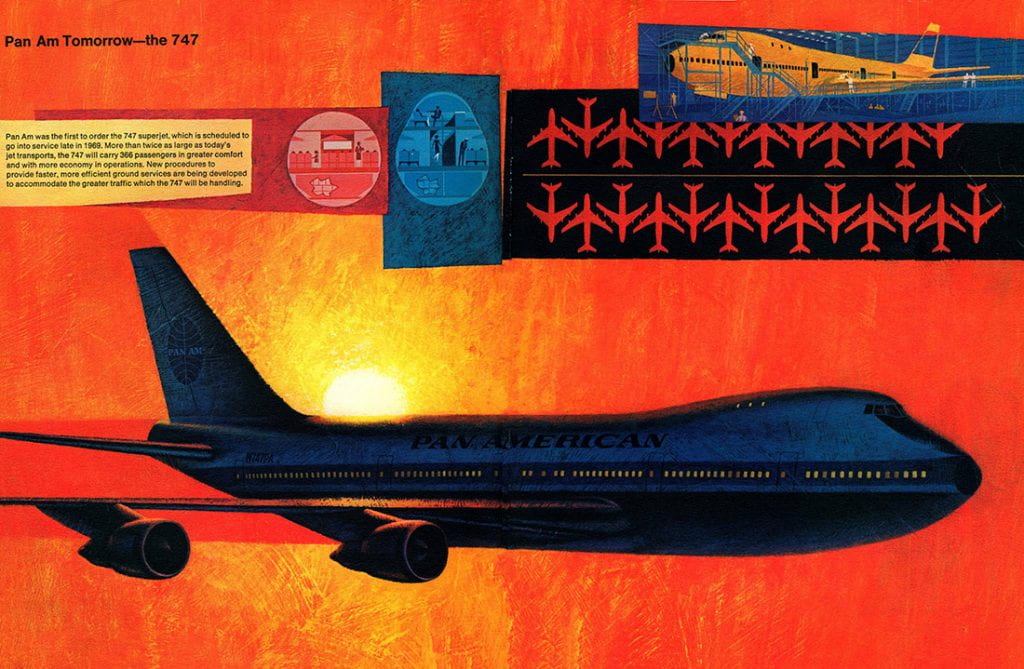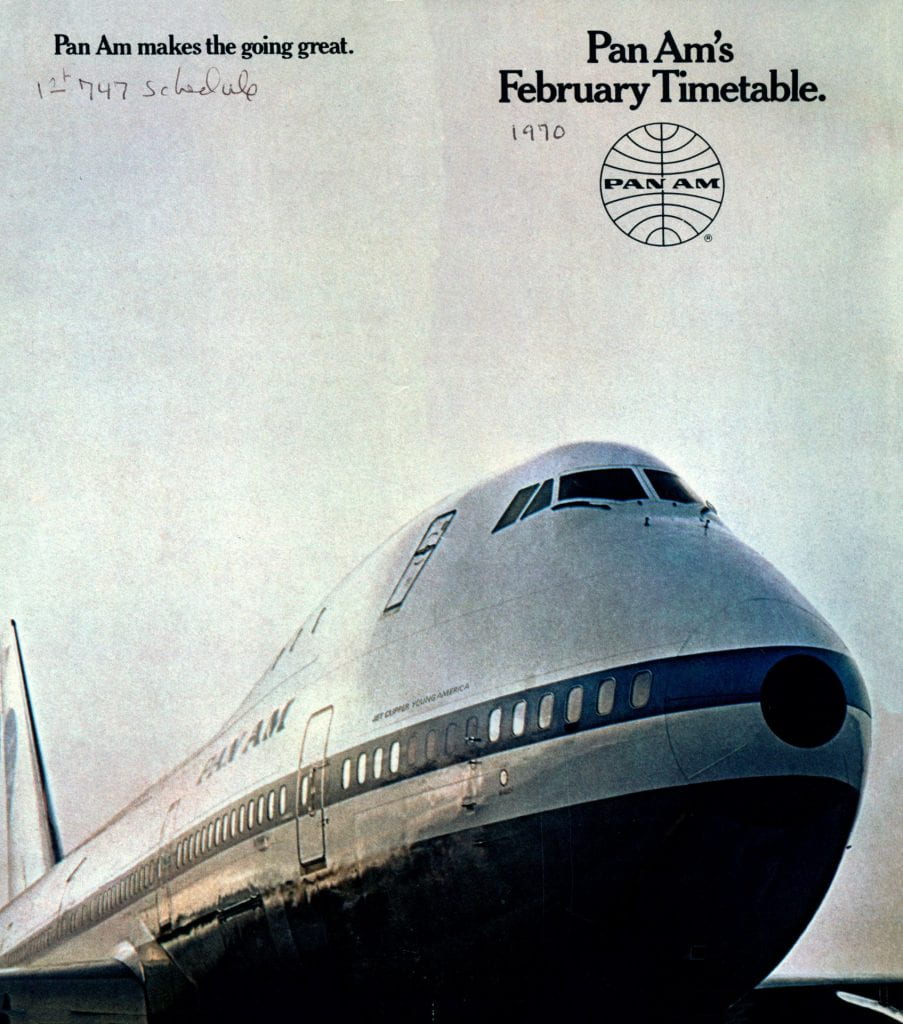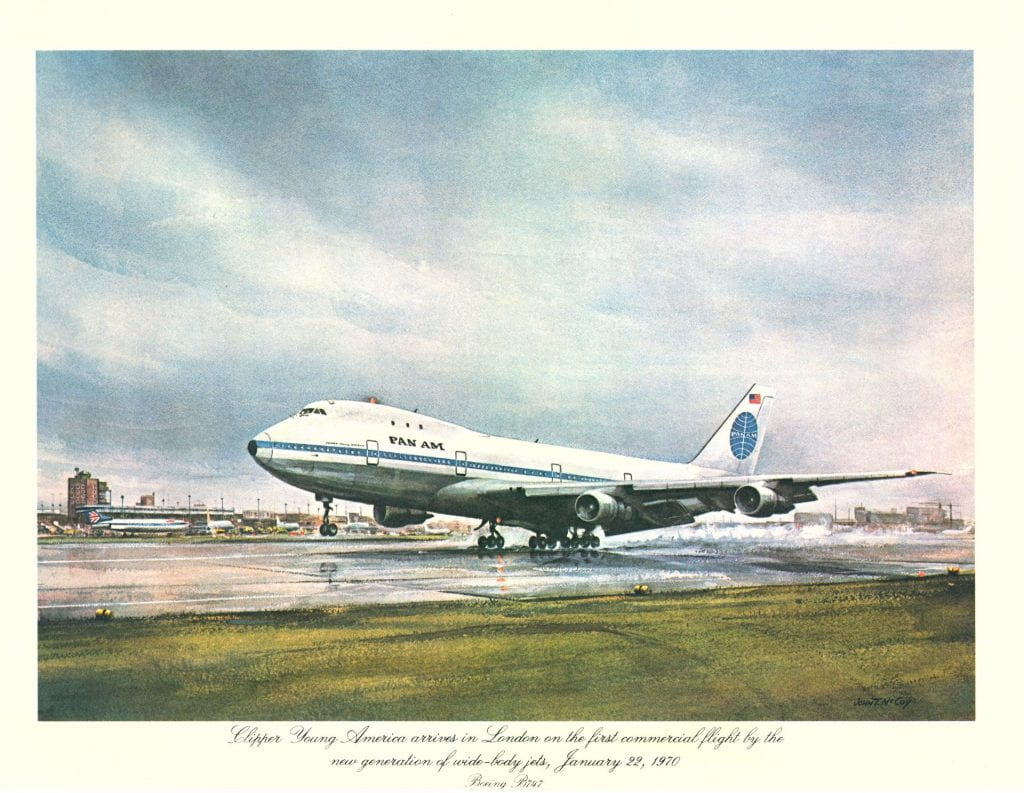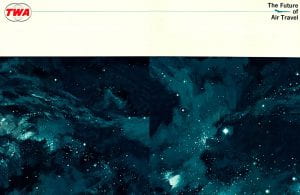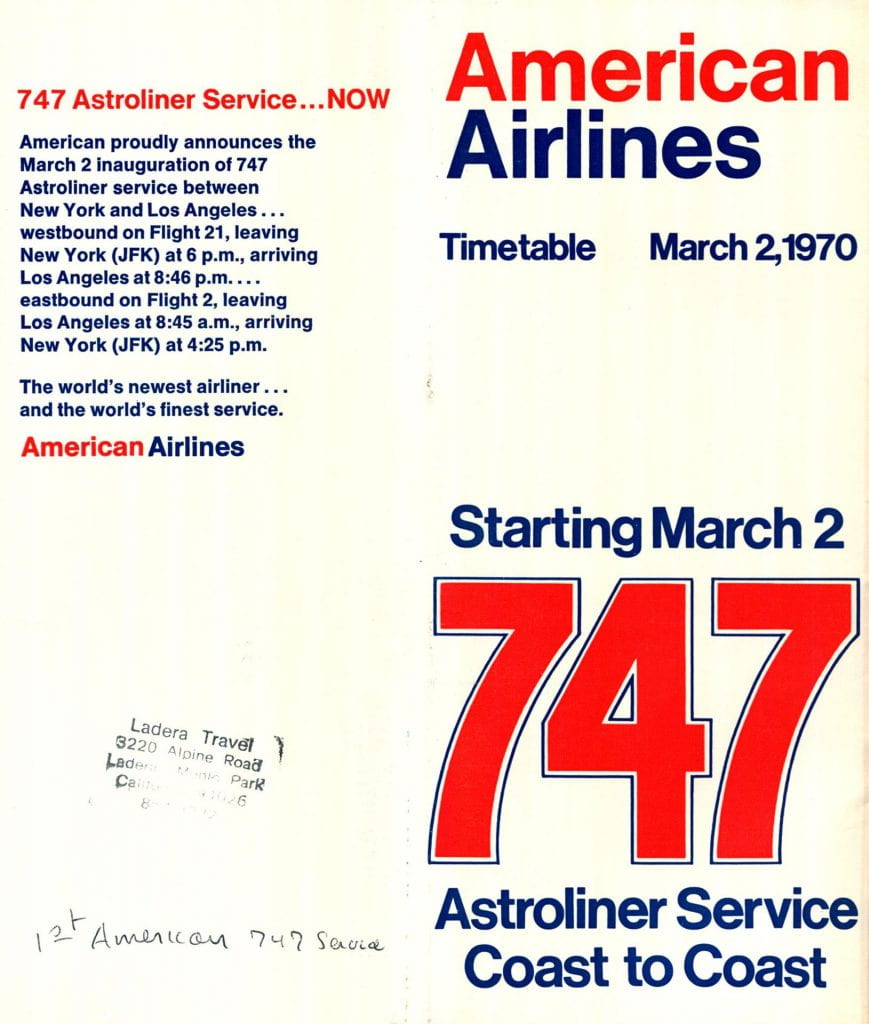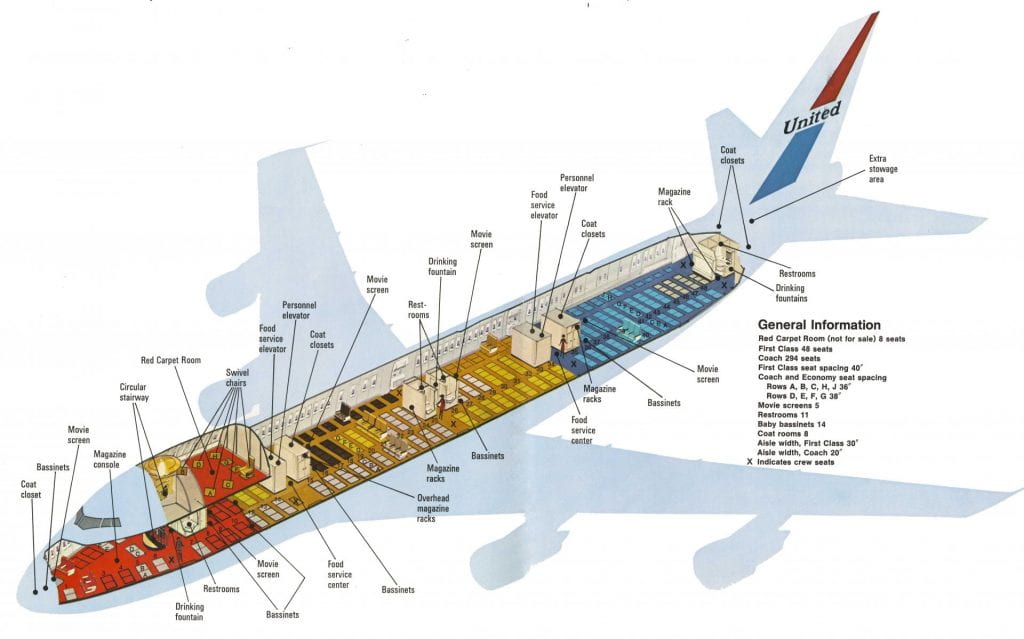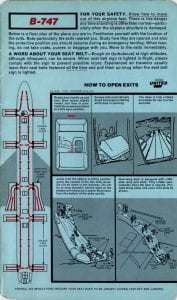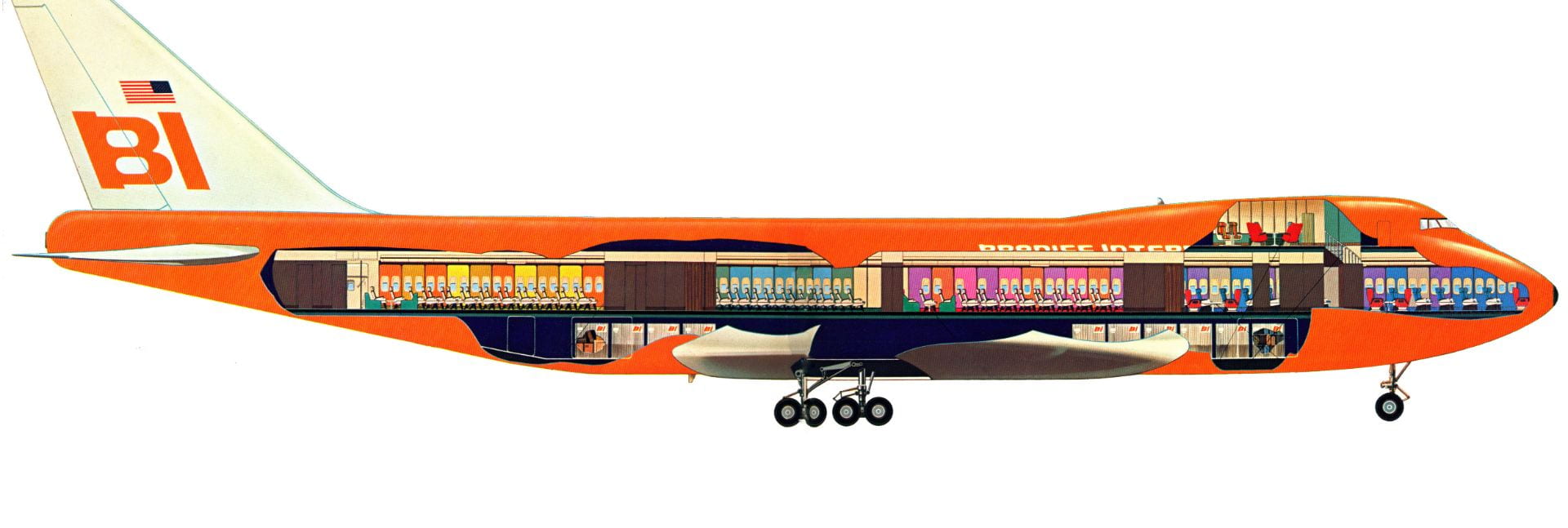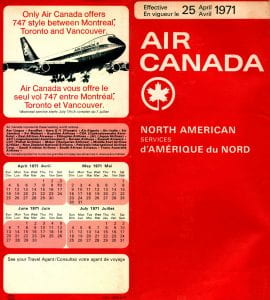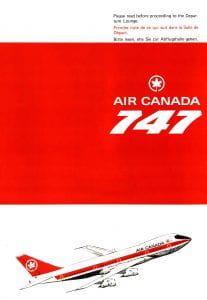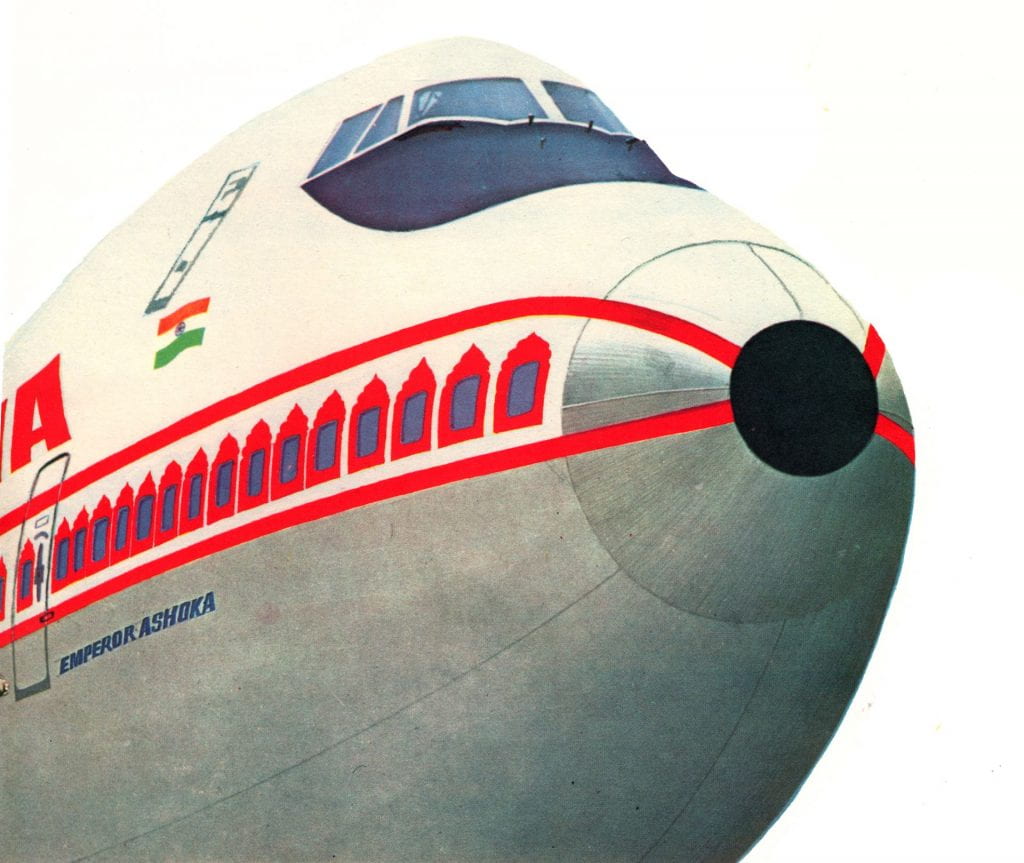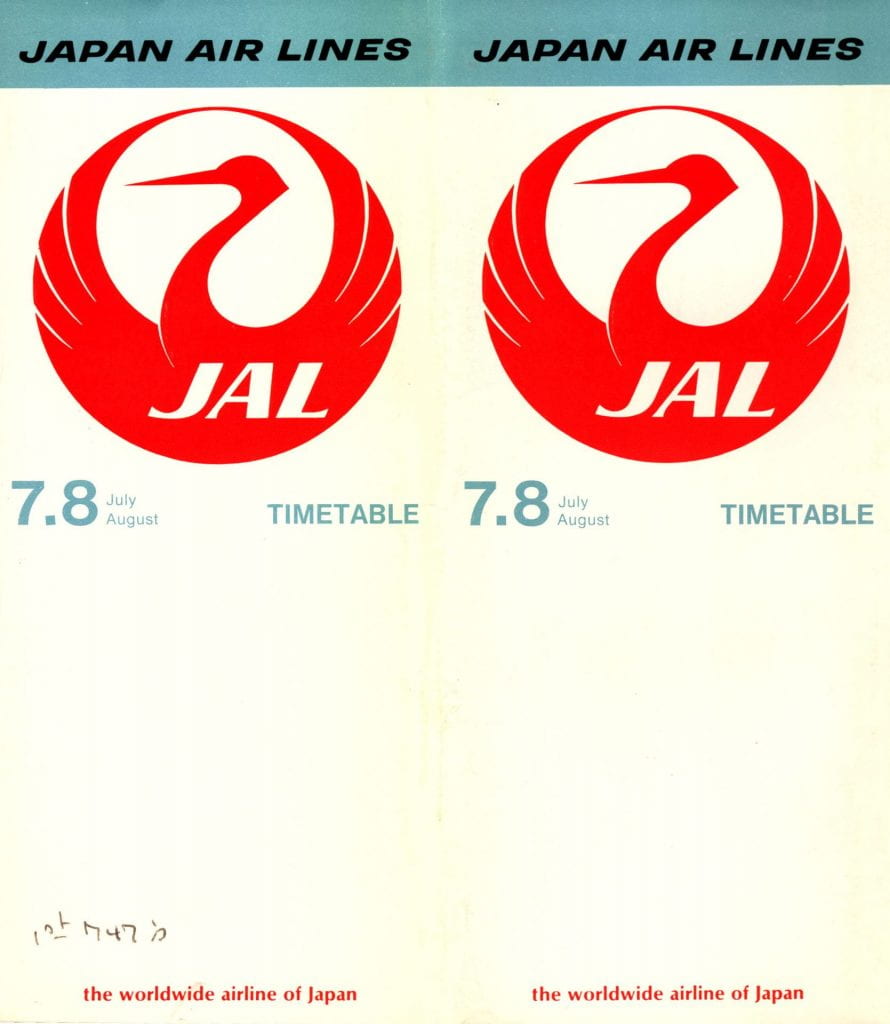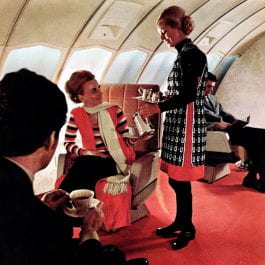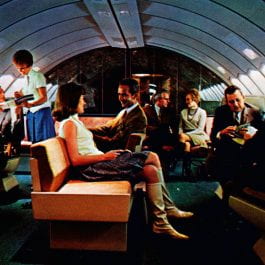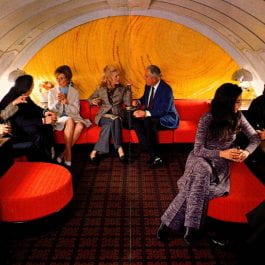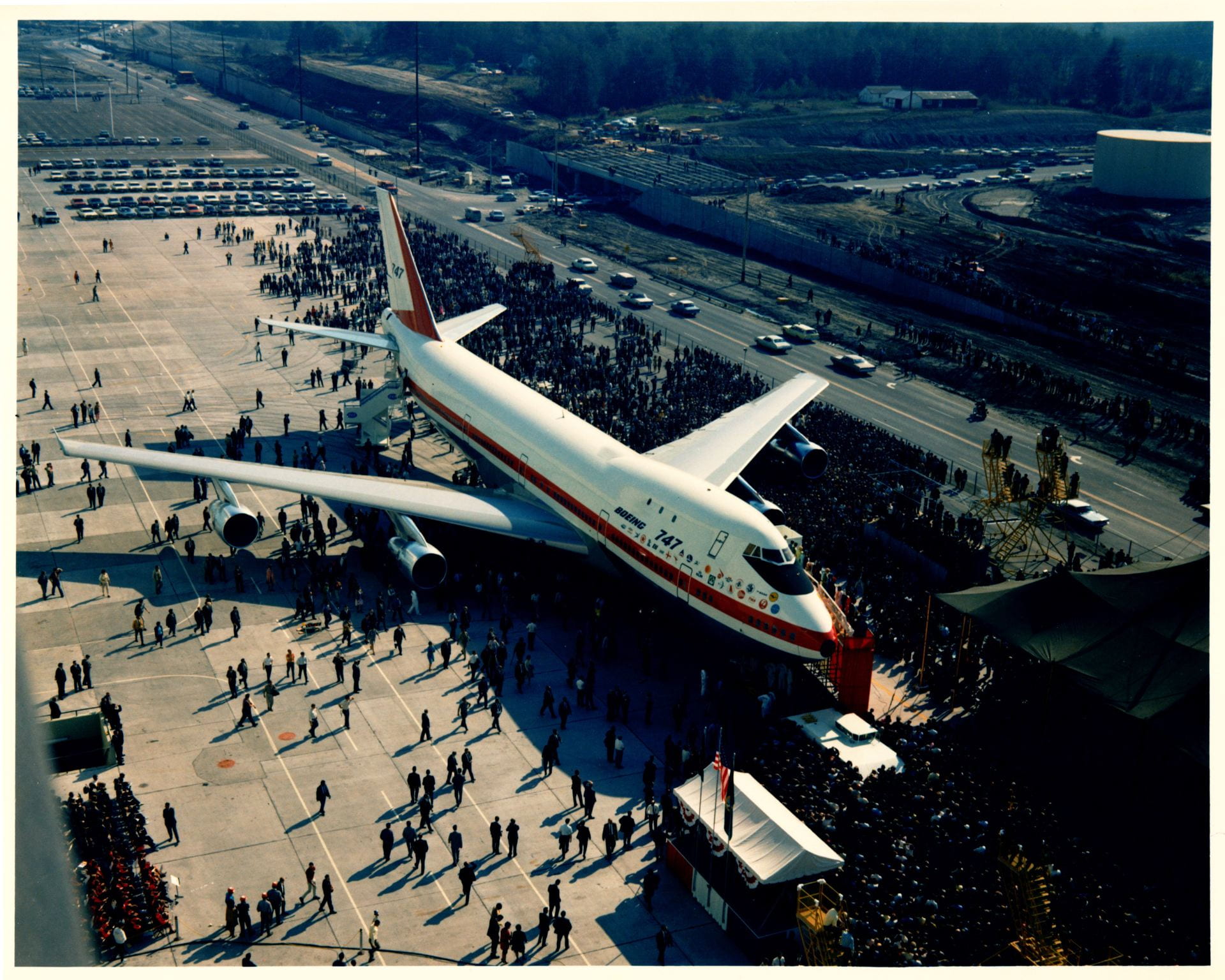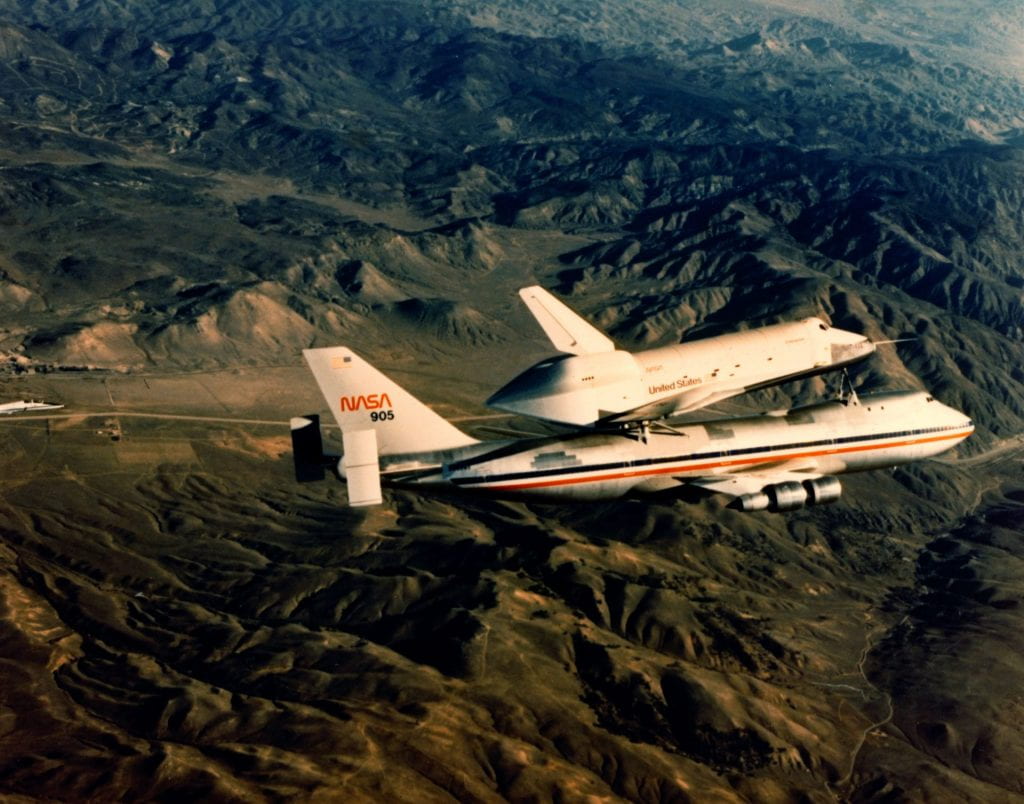Longer than the Wright brothers’ first flight, wider than a boulevard, and with a tail height as tall as a six-story building, the 747 was a revolution in aviation technology and the passenger experience when it entered service on January 22, 1970. With the first flight from New York to London, Pan Am’s Clipper Young America ushered in the jet age’s second phase: the era of wide body aircraft.
Developed by Boeing to maximize seat-mile and ton-mile revenues, the aircraft also extended the golden age of air travel as the 1960s came to a close. With increased capacity and lowered costs, the 747 helped make the air travel experience accessible to middle-class travelers. Spacious interiors with luxury appointments and enhanced in-flight dining and entertainment experiences, available to first-class and economy passengers alike, served as marketing tools for the airlines that operated the 747. The jumbo jet came to occupy a permanent place in the popular imagination around the world and remains, decades later, a symbol that represents the glamour of air travel in a bygone age.
This exhibit brings together passenger ephemera and other materials from the collections of Northwestern University’s Transportation Library to celebrate the jumbo jet on the fiftieth anniversary of the launch of 747 passenger service.
Development of the 747

First Flight Crew. Boeing 747 Anniversary Date
Development on the 747 program began in in the mid-1960s, with Boeing seeking to develop a commercial airplane that supported more efficient operations by carrying more passengers and cargo than already-existing aircraft.
The first order for the 747 began with a December 1965 conversation between Boeing President William Allen and Pan Am President Juan Trippe, and was said to have gone something like this:
Trippe: If you’ll build it, I’ll buy it.
Allen: If you buy it, I’ll build it.
The order was finalized in April 1966, with Trippe agreeing to buy 25 airplanes for Pan Am at $20 million each.
At the height of the project in 1968, some 20,000 Boeing employees were at work on the project. The 747 debuted on its first test flight on February 9, 1969. The First Flight Crew is shown above: Jess Wallick, flight engineer, Jack Waddell, pilot, and Brien Wygle, co-pilot, the first men to have ever piloted a 747.
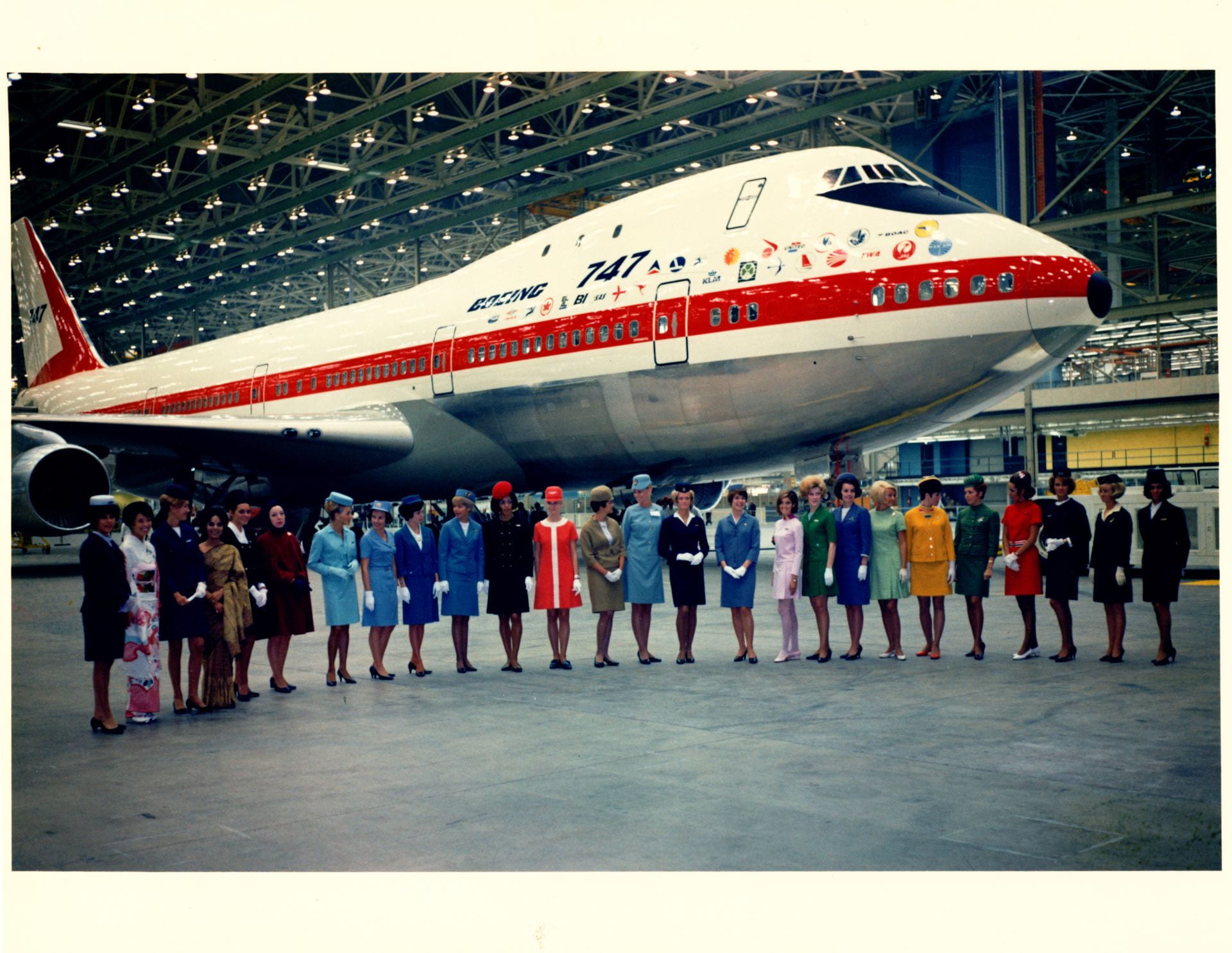
747 Launch Day. Boeing 747 Anniversary Date
On launch day, twenty-six flight attendants representing each of the airlines that had ordered the 747 posed in front of the aircraft in Boeing’s 747 assembly building in Everett, Washington. Over the next ten months an extensive flight test program followed, involving five airplanes and over 1,400 hours of flying. The 747 was certified by the FAA for commercial passenger service on December 30, 1969.
The 747 entered service with Pan Am on January 22, 1970. Following are timetables, menus, safety cards, and annual reports from some early operators of the jumbo jet, listed in order of each airline’s first 747 flight.
First Commercial Flight
Pan Am introduced its first 747 service on January 22, 1970. Originally scheduled for January 21, the inaugural flight was delayed when technical difficulties grounded the aircraft that had been slated to make the journey. It was a second 747, originally named Clipper Victor but which Pan Am quickly re-christened Clipper Young America, which carried 335 passengers and 20 crew members from New York’s JFK Airport to London Heathrow on the first commercial flight of a 747.
Pan Am’s February 1970 timetable, the first listing 747 service, celebrated the new wide body jet on its cover.
The 747’s landing in London was commemorated in a watercolor by John McCoy, part of a series celebrating historic first flights by Pan Am aircraft. The in-flight menu shown below, collected on an August 1985 flight, is one of a run from that era that featured the paintings on their covers.
“Pan Am’s New 747,” read the postcard shown below, “The plane with all the room in the world.”
TWA
 TWA took delivery of its first two 747s on December 31, 1969 and introduced scheduled service on February 25, 1970. The following month, the airline opened Flight Wing One at New York’s Kennedy Airport. The first terminal built expressly to accommodate the 747 and other wide body aircraft, it had seven passenger gates with the capacity to handle four 747s and three 707s simultaneously.
TWA took delivery of its first two 747s on December 31, 1969 and introduced scheduled service on February 25, 1970. The following month, the airline opened Flight Wing One at New York’s Kennedy Airport. The first terminal built expressly to accommodate the 747 and other wide body aircraft, it had seven passenger gates with the capacity to handle four 747s and three 707s simultaneously.
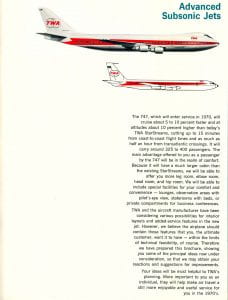
Like other airlines that ordered the 747, TWA worked with Boeing to customize the aircraft to its specifications. A survey was distributed during the design phase, with the airline inviting public input on cabin arrangements that included potential partitions between seats in economy class, luxury roomettes in first class, walk-in closets, and a separate nursery playroom section.
The airline featured the 747 on the cover of its February 1, 1970 timetable along with a crew of fourteen posing in front of the aircraft. By the end of the year, the airline had fourteen 747s on hand, with an additional five on order. The following year, TWA pioneered containerized air freight service, carrying cargo in the bellies of its 747s within the United States.
American Airlines
Competition among airlines to introduce the new series of jumbo jets was fierce. To accelerate its entry into 747 service, American Airlines leased two early-delivery 747s from Pan Am in early 1970. It was with one of these leased aircraft that American Airlines introduced its first 747 Astroliner service, on March 2 of that year. A second leased 747 and the airline’s own fleet of sixteen 747s would be delivered later in 1970.
United Airlines
United Airlines took delivery of its first 747 in June 1970 and introduced the jumbo jet into service on July 23. In keeping with its Fly the Friendly Skies campaign, United named its 747 the Friend Ship. Like other airlines that received the 747, United took pains to differentiate its 747 service from the other airlines that put the jet into service and emphasized the warmth and personal service that passengers could expect to find on board: “For all its size, it’s intimate.”
The launch pamphlet for the Friend Ship included a cutaway diagram of the aircraft’s interior, illustrating seating arrangements and on-board amenities including five movie screens, eleven restrooms, and fourteen baby bassinets. The aircraft also included two food service elevators and two personnel elevators.


A half-fold safety card, printed on heavy blue card stock, listed safety procedures for water and ground landings. The card shown here was printed in the Friend Ship’s first month of service in July 1970.
National Airlines
National Airlines introduced its 747 service in October 1970 on its Miami – New York and Miami – Los Angeles routes. The two Boeing jets, named Patricia and Elizabeth (later renamed Jacqueline and Linda) and also known as the Sun Kings, were the only 747s that the airline acquired. National deemed the McDonnell Douglas DC-10 more suitable for its domestic routes, and it acquired nine of the smaller wide body jets in 1971.
Braniff International
Braniff International’s first 747 was placed into service on a daily round-trip between Texas and Hawaii on January 15, 1971. Known alternately as Big Orange and 747 Braniff Place, it was marketed as “a place to live well in flight.” With a 185-foot-long cabin, passengers were promised the freedom to roam across six lounges and ten conversation foyers before returning to the privacy and comfort of wing-backed, contoured chairs.
Air Canada
Air Canada took delivery of three 747s in 1971 and inaugurated its service with the new aircraft on April 25, 1971 on a daily non-stop flight between Toronto and Vancouver.

Passengers flying on Air Canada’s 747 would have received the pamphlet shown at left with information on what to expect aboard the wide body jet. The color-coded diagram of the plane’s interior and classes corresponded with color-coded boarding passes, designed to help passengers navigate the boarding experience in the plane’s four cabins.
Air India
Air India took delivery of its first 747 on March 22, 1971. The aircraft entered into service on May 21 of that year, with service four times weekly from India to the United Kingdom. The airline debuted a new look in its aircraft exterior: silver and white with red details, it had windows described as Rajasthani style arches, intended to give the effect of a row of Jahorka type balconies reminiscent of the Hawai Mahal at Jaipur.
The airline’s safety card for the 747 is shown below.

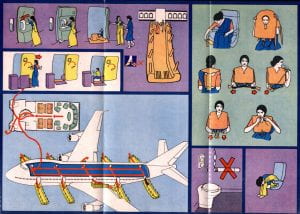

Japan Airlines
Japan Airlines launched its first 747 service on July 1, 1971 on the Tokyo-Hong Kong and Tokyo-San Francisco-via-Honolulu Routes. Each section of the Garden Jet was designed around the theme of Japanese gardens: First class featured the Garden of Wisteria, the first-class lounge was called the Teahouse of the Sky, and the Gardens of Wild Orange, Pine, or Maple made up the three sections of economy class.
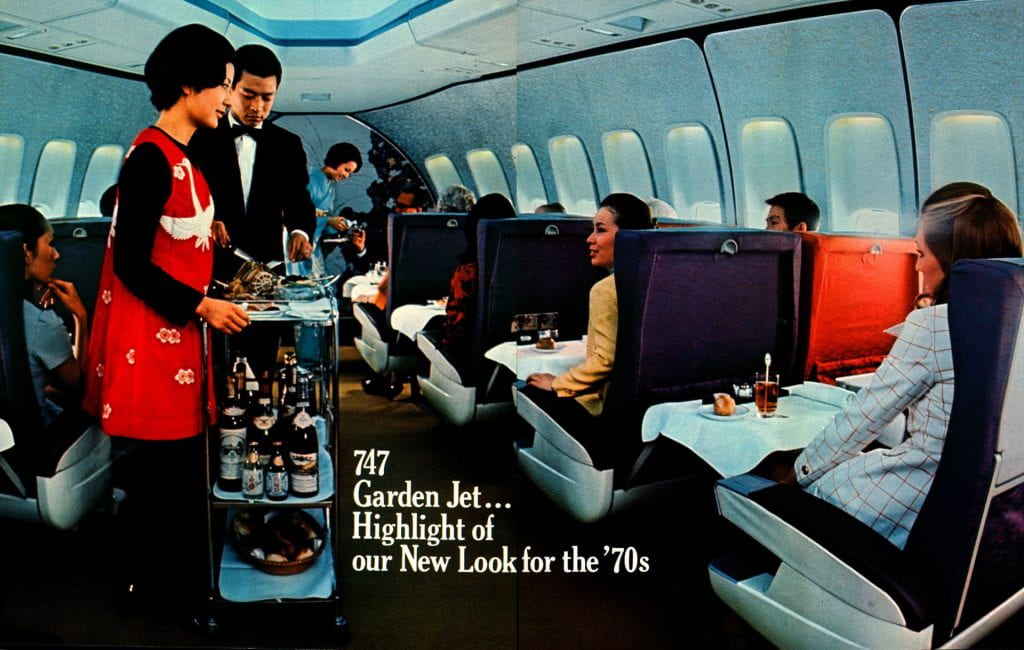
A Japan Airlines menu collected on a July 15, 1973 Tokyo – San Francisco flight provides examples of the food and beverage options offered on the Garden Jet. Passengers on this flight would have been served two meals on the flight: dinner, and a Pacific Morning Plate.




The First-Class Lounge
The 747’s upper-deck lounge was initially conceived of by Boeing as a rest area for flight crews. In consultation during development with Pan Am chairman Juan Trippe, it became the first-class passenger lounge that the aircraft was known for.
The lounge took form under the various operators, and was named the Tea House in the Sky on Japan Airlines, the Red Carpet Room on United Airlines, the Penthouse Lounge on TWA, and the International Lounge on Braniff.
In the years that followed the 747’s launch, several variants of the aircraft were developed, updating technology with more powerful engines, longer ranges, increased seating capacities, and other improvements. Two notable variants include Air Force One, the aircraft that carries the President of the United States; and Shuttle Carrier Aircraft, a 747 modified to carry the Space Shuttle. The 747 was retired from passenger service by its last U.S. operator in 2017 but, as of December 2019, continues to be flown by other airlines worldwide including the largest operator British Airways.
Notes on Notes
Many of the timetables in this exhibit, including the 1976 Swissair timetable shown here, come from the Transportation Library Menu Collection. The donor’s handwritten annotations can be found throughout the collection and indicate milestones in aviation history, such as an airline’s first 747 service, or notes on the passenger experience, such as commentary on in-flight food or service.


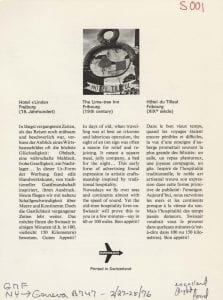
More Information
Items in the exhibit are housed at Northwestern University’s Transportation Library. Email transportationlibrary@northwestern.edu with questions, or to schedule an appointment.

